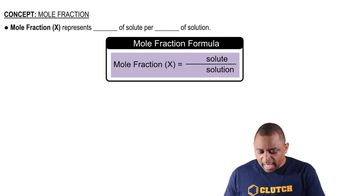Here are the essential concepts you must grasp in order to answer the question correctly.
Percent by Mass
Percent by mass is a way to express the concentration of a solution, indicating the mass of solute present in a given mass of solution. In this case, a 6.45% glucose solution means that there are 6.45 grams of glucose for every 100 grams of solution. This concept is essential for determining the mass of solute in a specific mass of solution.
Recommended video:
Molar Mass
Molar mass is the mass of one mole of a substance, typically expressed in grams per mole (g/mol). For glucose (C6H12O6), the molar mass is approximately 180.18 g/mol. Knowing the molar mass allows us to convert between grams of solute and moles, which is crucial for calculating the number of moles in a solution.
Recommended video:
Moles of Solute
The number of moles of solute can be calculated using the formula: moles = mass (g) / molar mass (g/mol). This relationship is fundamental in stoichiometry and solution chemistry, as it allows us to quantify the amount of solute present in a solution, which is necessary for various calculations in chemistry.
Recommended video:





